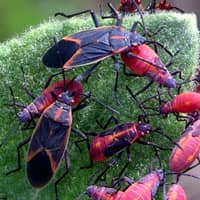
Box Elder Bugs

Box elder bugs are a type of nuisance pest that enters into homes and other buildings during the late fall season. They do this in order to have a safe place to overwinter in. When the weather is warm they can be found in large numbers, infesting seed-bearing box elder trees, along with maple, cherry, and ash trees.
Box Elder Bug Identification
Adult box elder bugs are about 1/2 of an inch in length and appear black in color. They have distinctive red lines running along their thorax and sides. Their wings lay flat against their body and are red in color. Young box elder bugs are redder in color than adults and are smaller and plumper in appearance.
Habits & Life Cycle Of Box Elder Bugs
Box elder bugs feed on the leaves, shoots, and seeds of the trees that they are infesting. They also use the trees that they invade to breed in. They will lay their rust-colored eggs in the trees or on the leaves of it. The eggs will hatch in just a few short days, and the nymphs will molt many times during the summer until they reach adulthood.
When the weather cools off they move inside through cracks and crevices of exterior walls, they will hide in crawl spaces, attics, and behind wall voids. Box elder bugs do not eat or breed during this dormant period; when the weather warms up again they move back outside to breed and feed on their host trees.

Trust Massachusetts' oldest family owned pest control company to protect your family & home.